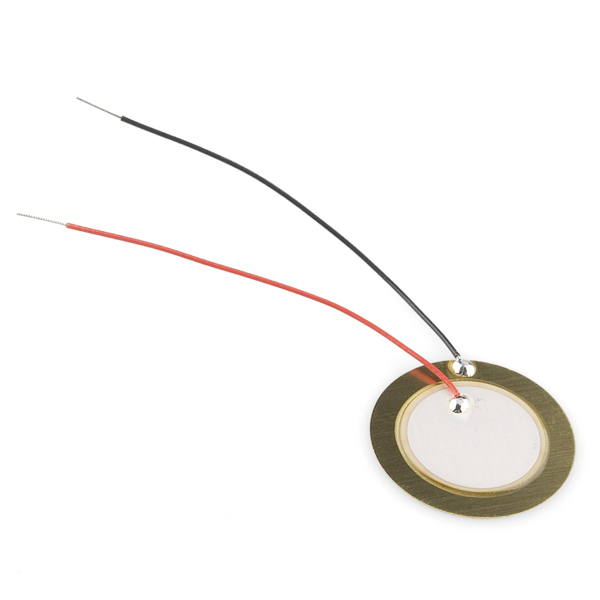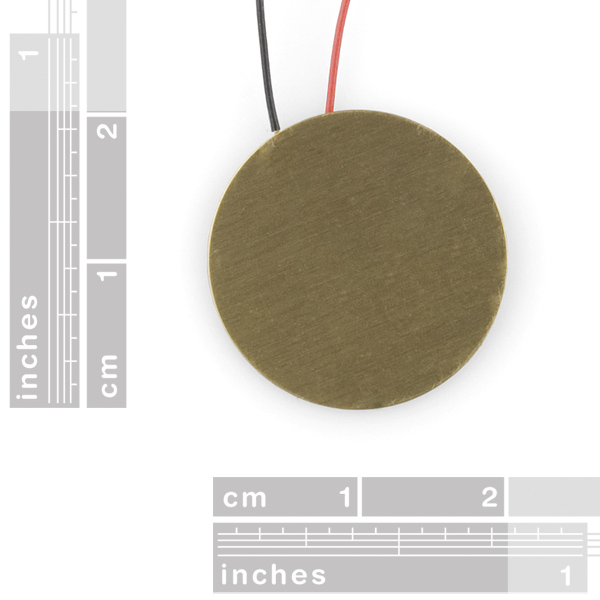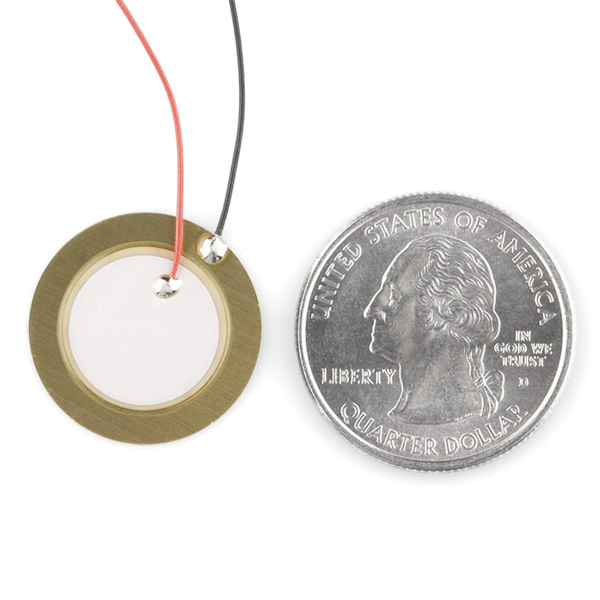Piezo elements come in handy when you need to detect vibration or a knock. You can use these for tap or knock sensors pretty easily by reading the voltage on the output. They can also be used for a very small audio transducer such as a buzzer.
- Datasheet (7BB-20-6L0)
- Arduino Tutorial
Piezo Element Product Help and Resources
Resources and Going Further
For examples using a piezo, check out the following:
Core Skill: Electrical Prototyping
If it requires power, you need to know how much, what all the pins do, and how to hook it up. You may need to reference datasheets, schematics, and know the ins and outs of electronics.
Skill Level: Rookie - You may be required to know a bit more about the component, such as orientation, or how to hook it up, in addition to power requirements. You will need to understand polarized components.
See all skill levels
Comments
Looking for answers to technical questions?
We welcome your comments and suggestions below. However, if you are looking for solutions to technical questions please see our Technical Assistance page.
Customer Reviews
5 out of 5
Based on 2 ratings:
5 of 5 found this helpful:
Works great, need some mass
This piezo element needs some mass to make a loud noise or detect vibrations.
After I did that, it has a nice high pitched frequency range. It can also detect footsteps throughout my entire house with the standard Arduino ADC and no amplification. How awesome is that?
1 of 1 found this helpful:
Very sensitive
Nothing to add to the previous review - put some mass on (not a lot though) and it will detect slightest vibrations. Make sure it suits your application though.





Can this be safely used with the Max3232 breakout (BOB-11189)? I couldn't find a max Vp-p rating in the datasheet or on this page.
I am considering using the piezo pressure sensitive element on a motorcycle to determine when the rider is attempting to up shift, pull the shift lever up. I need to know the amount of pressure applied, to avoid false/positive shift attempts(e.g. accidentally touches shift lever). I also need to know when the shift has been completed (shift lever released by rider).
Will the piezo element continue to return positive values while pressure is applied, when polled via GPIO, or does it return a single value the first time pressure is applied?
With wires ALREADY soldered on? Now that is convenience! At least to those of us who are used to getting them without wires. The disk proper is usually more likely to just be neighborly to solder than friendly..
Yeah, like cuts-grass-at-5AM-on-holiday neighborly.
Does the knock have to be on the piezo element or just on the same surface?
It has to make the piezo element vibrate. If firmly attached to a surface like a door knocking on the door will cause it to vibrate. If firmly attached to a piece of foam, well, probably not. So it depends on the surface and the method for mounting.
Any trick or tips to boost the loudness of this element when using it as a speaker? It's pretty quiet on it's own -- even with 5V PWM. I understand it is a transducer and, sure, it works great under a pint of beer. I was hoping to make something loud, yet, low profile with this.
Got a high sensitivity vibration sensor working nicely with Ardiuno Uno, including code to avoid false positives. More in my blog at http://davidhoulding.blogspot.com/2014/11/advanced-high-sensitivity-vibration.html
Used this in a high sensitivity vibration sensor for Ardunio. Blog with details
If I rip off the speakers off a pair of cheap earbuds and replace them with two of these... do I get music playing in my skull?
You'll get buzzing more than music. If you want to make 'inner-skull speakers', take a look at these small audio transducers.
buzz buzzz - pwm is that you talking? knock knock - analog says "Who's There"
I'm looking to miniaturize my project that currently uses this buzzer for tones (https://www.sparkfun.com/products/7950). Is this capable of playing tones and would it be as loud? Is this the smallest option? I am looking to add tones to a small PCB to put inside a digital thermometer of sorts. Thanks!
Would this be able to measure the level of a voice if placed near the neck or mouth?
Another question I have is, would this be able to detect Tremors or "shakes" in some ones hand without picking up normal movements and vibrations (example of normal vibrations: putting a hand on the table or object)?
Thanks in advanced
Are you trying to measure SPL? What types of tremors/shakes are you trying to pick up?
If I put a straight dc current through this will it buzz? Trying to find a cheap buzzer for the "squishy circuits" projects.
Does anyone have experience using the this piezo element as a throat microphone? i have seen projects where it has been used as a guitar pickup, but i haven't seen anyone use it to record voice. can this pickup the vibrations of my voice if it held against my throat? i trying to find a super simple microphone circuit that can record my voice in very windy conditions.
yes. it works, and sounds really cool and somewhat muffled. you can make some really weird noises with it that you usually can't.
Hi, do I need a zener diode or a simple resistor in parallel is enough ? Which is the maximum voltage produced by the piezo ? Bye
Is this product identically to SHOCK SENSOR 801S?
Would I be able to use this and a simple transistor circuit to detect taps using this piezo element and light up some LEDs based on vibration? I am planning a light up drum project and I need something to detect hits.
These can be handy for detecting small signals when troubleshooting. They're not picky about voltages so you can use them places you can't use a logic probe; I've stuck them on RS485 serial lines for instance, one pin on signal, one on ground, for audio feedback when anything is happening.
They have a (relatively) big capacitance though so would probably badly distort anything analog you attach them to.
These work as awesome pickups for small scale guitar.
Does anyone know if these things, held against the chest or a wrist, would be able to pick up your heartbeat?
Maybe, but these definately will! http://www.sparkfun.com/products/9196 send me a link to your project if you ever get around to making it!
Could I stick one of these in a sugru cube and have a working, if crappy, surface speaker? Because I have driven a piezo buzzer from a Melody sketch uploaded to my SerIO...
These work well as surface speakers, the sound quality is not 'crappy'
I connected the red lead to the positive of my multimeter and the black lead to the ground. Shouldn't I be getting some voltage by knocking on it? All I get is a few millivolts (negative values too). I used it with a 2.2 KΩ resistor.
A digital multimeter isn't going to be fast enough to see it, especially since the signal goes positive, then goes back negative. A multimeter would average the brief pulse out to zero.
Maybe try w/o the resistor?
How similar are these to the elements in Nike+Ipod devices?
Very very similar. I don't know the exact specs on the Nike iPod piezo, but they are functionally identical.
Tutorial with pictures of what we're talking about: http://www.sparkfun.com/tutorials/41
Cool, I didn't know you guys had a tutorial on that.
They have a tutorial on everything, lol :)
just a warning to everyone out there watch out for the solder joints i havent specifically tried these ones that sparkfun has ordered but all others that i have used, the leads fell off
The need for strain relief is assumed. You will need to make sure the wires don't move excessively. Also, the wires can be soldered back easily.
A little hot glue or epoxy should do the trick ;)
even bare conductive paint :)
Be extra careful if you're soldering to the back of these. The inner wire is attached to a sputtered layer, which is solder soluble (in my experience). This means that excessive soldering reduces electrode area, and the sound output is reduced proportionally. If you're aware of this, and don't spend forever soldering it (I was using it for a ground plane on a tiny alarm clock), you should be fine.